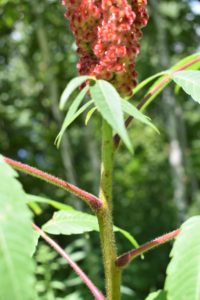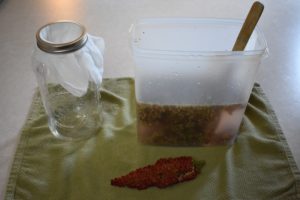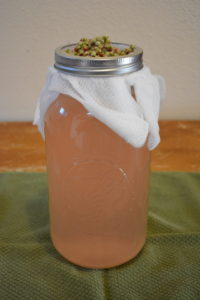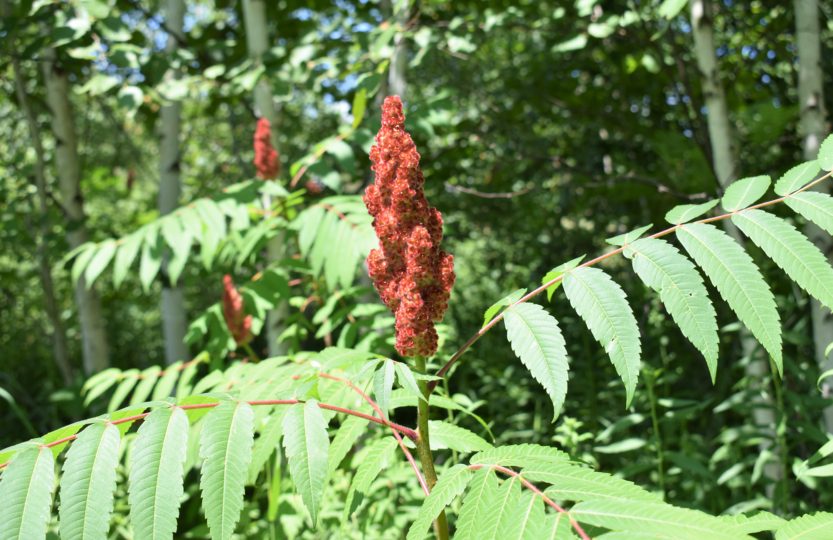At home, I love being surrounded by my favorite plants that remind me of my childhood. I’ll always remember walking down my family’s dirt road with a bucket for picking blueberries and raspberries making my way to some of the choice berry picking places of my youth. Along the way, two plants stick out in my memory more than any other. Maybe, it was the fact that there were only a few growing there, or perhaps, it was the location which seemed to be so very mysterious at the time. Either way, I will never forget the few solo Common Milkweed plants hanging out by the Staghorn Sumac that captivated my attention nearly every time I made it to the end of the road. In thinking back to these moments, my heart feels grateful to have had these opportunities to connect with nature at a young age.
In watching my son grow up now, I sometimes find myself wondering what his most memorable experiences in nature will be. I find it really awesome that, as a mother, I can return to some of these memories when we explore our own backyard and the surrounding woods. As we wait for the Sumac “berries” to fully ripen, I thought it would be fun to share about Sumac here. My son and I are getting excited to make Sumac Lemonade together, and I would like to share the excitement. If you’ve never made or heard of Sumac-ade, give it a try. It’s a great activity to share with the children in your life and a great, nutritious way to cool down during these hot, late-summer days.
How do you Identify Sumac?
There are three kinds of Sumac I’m going to briefly cover here: Poison Sumac, Staghorn Sumac, and Smooth Sumac. All three are common in Minnesota. I’ll start with the first, Poison Sumac, since harvesting and consuming this type of Sumac could be a deadly mistake. Know that these brief descriptions are not meant to be used solely for identification purposes. These are just brief descriptions to get you started and give you a few links to some online identification tools. Investing in a few reliable identification guides is a good thing. I always use several resources to cross-check my identification, and I NEVER consider harvesting a plant unless I am 100% sure of my identification and know about toxic look-a-likes.
Poison Sumac, Toxicodendron vernix, is drastically different from the two types of edible Sumac we’ll talk about here. It is actually from a completely different genus, the same genus as Poison Ivy and Poison Oak. The flowers are white and hang from the leaf axils of the shrub. The ripened fruit is yellowish white and the drupes hang in clusters. Look at the pictures of Poison Sumac at Minnesota Wildflowers. They point out the differences by saying:
It is easily distinguished from “safe”—and in fact quite edible—Sumacs by its toothless leaflets and more so by its creamy, hanging fruit clusters as compared to the serrated leaflets and bright red, erect clusters of our other Sumac species.

Staghorn Sumac, Rhus typhina, is the kind of Sumac I harvest for Sumac-ade and is the Sumac I am most familiar with. Notice in the picture to the left how its twigs are covered in velvety hair. The leaf stalks are also hairy. The upright fruits turn deep red to almost a purple color as they ripen. The picture at the top of this post is also Staghorn Sumac. Notice its compound leaves. You can read more about its distinguishing characteristics HERE at Minnesota Wildflowers.
Smooth Sumac, Rhus glabra, is another type of edible sumac in northern Minnesota where I live. Its twigs and leaf stalks are hairless. This makes it easy to distinguish them from Staghorn Sumac. Its upright fruits also ripen to a deep red similar to that of Staghorn Sumac. Both Staghorn Sumac and Smooth Sumac are edible and can be harvested for Sumac-ade. The “berries,” which are actually considered to be drupes, are easy to harvest for immediate use or preserved for later.
How do you Sustainably Harvest Sumac?
* The decision to harvest any plant is one that only you can make. You are solely responsible for your own decisions in doing so. Thoroughly researching, cross-checking your identification, and verifying it with a professional is a wise decision. Always familiarize yourself with potential look-alikes, potential side-effects, and any herbal cautions that may apply to the wild food you are interested in harvesting. As writer of this blog, I hold no liability for your decision. I only share my own personal experiences and knowledge. Use utmost caution in your choice to harvest any wild food. If you choose to make the harvest, that is your own personal decision.
Once you are 100% confident in your identification, make sure that the place you plan to harvest is a place away from potential pollutants. Avoid areas that could have been sprayed with any type of chemicals. Sumac loves to live in ditches near roadways and also along railroad tracks. Both of these places can be good places to enjoy the beauty of these shrubs and get to know their characteristics. However, both places are prone to pollution and spraying. Only plan to harvest in healthy environments that you can trust to be chemical-free. Wait to harvest until the Sumac has ripened to a deep red but before the rain has washed away its flavor. The “berries” should be sticky to the touch and taste tart.
Take along a pair of pruning shears or a small knife to cut off the fruiting stalks. Some people will quickly snap the stalk off without the use of a tool, but I like to make a clean cut to avoid stress to the shrub. Pruning shears do the trick nicely. Make sure to tread lightly in the area that you plan to harvest from and only harvest what you plan to use without over-harvesting in any given area. Remember, all natural environments are somebody’s home and the web of life is really an AMAZING thing. Be wise and respect the earth. We should care for our mother like she cares for us! Give thanks for your harvest in your own way. We have a lot to be grateful for.
How do you Prepare Sumac-ade?
 Here is a simple Sumac-ade recipe to try for yourself. Only try a small amount of any new-to-you foraged food. Allergic reactions can happen. Make sure that the new food agrees with you. Everyone is different. Since Sumac is a member of the Cashew Family, if you are allergic to cashews or mangoes, you may want to avoid it completely. This simple Sumac-Ade recipe is high in Vitamin C and is a nutritious way to stay refreshed on hot, late-summer days.
Here is a simple Sumac-ade recipe to try for yourself. Only try a small amount of any new-to-you foraged food. Allergic reactions can happen. Make sure that the new food agrees with you. Everyone is different. Since Sumac is a member of the Cashew Family, if you are allergic to cashews or mangoes, you may want to avoid it completely. This simple Sumac-Ade recipe is high in Vitamin C and is a nutritious way to stay refreshed on hot, late-summer days.
Late Summer, Simple Sumac-ade
- Place a few stalks of unwashed Sumac “berries” in a container with 1 quart of cold water covering it. It is important to make sure the water is cold. Warm or hot water will leach tannins from the stalk and make your Sumac-ade bitter. Pre-washing your Sumac will wash out the tart taste. It will be strained in a later step. Visually inspect the stalks for mold or bugs.
- Steep for a couple of hours returning to the container a few times to squeeze the fruit breaking apart the individual drupes from the stalks and releasing the flavor into the water it is steeping in. Prior to the next step, make sure the water has turned pinkish in color. You can also taste the liquid if you would like. Steep for longer if needed. You may also want to steep less. Flavor differs across Sumacs.

- Cover a quart jar with a cheese cloth, towel, or coffee filter, and carefully, transfer the liquid from the container used for steeping into the quart jar. Once all the liquid has drained into the jar through the cloth or filter, squeeze the fruit pulp allowing for any remaining liquid to drain into the jar.
- Taste! Try your Sumac-ade before adding any kind of sweetener. Should you choose to sweeten it, you can experiment with honey, maple syrup, stevia, or sugar. I prefer maple syrup.
- Chill and enjoy! Your left over Sumac-ade can be stored in the refrigerator to enjoy over the next several days.
Have you Checked out the Products at Nature Art Exploration?
Nature Art Exploration has products in the shop that can aid you in some of the explorations here. Visit the shop and check out the great books by Sam Thayer while you’re there! The Forager’s Harvest DVD is also excellent. It has over 3 hours of instruction covering all 32 plants that were covered in his Forager’s Harvest book (including Sumac). I continually return to these books, and the DVD as references.
*This post contains affiliate links. A small percentage of all the purchases you make by following the above links will help support this site. Thank you for choosing to support Nature Art Exploration!*
Mike Krebill, who is now retired, also has a book titled The Scout’s Guide to Wild Edibles: Learn to Forage, Prepare, and Eat 40 Wild Foods. It came out in 2016. Although I have not read the book, it comes with great recommendations and includes a method for preparing Sumac-ade with the use of cold water. As a 7th grade science teacher, he worked for twenty years with his science class and boy scouts in the preparation of Sumac-ade. What a wonderful thing to reach so many children during his career connecting them to the land through nature and science.
Thank you for joining Nature Art Exploration in making Sumac-ade and learning more about this wonderful shrub! Please, feel free to comment below with any of your own experiences or knowledge. Nature Art Exploration always loves hearing from you!






